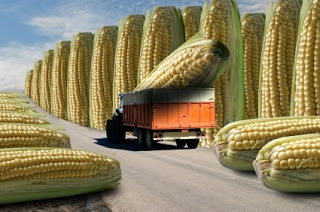

| Visitors Now: | |
| Total Visits: | |
| Total Stories: |
Avoiding GMOs
Sometimes I need a reminder as to what we are dealing with regarding GMOs. As with so many other things in life, deception is often the rule.
The lists and information below are not all inclusive and may not reflect the latest details on what products contain GMOs and which do not.
Not spending our money to support the genetically engineered food industry is one small thing we can do to fight back against corporate power and corruption and to help preserve our health.. If enough folks watch where their dollars go, it could become a major signal flashed all across the country that “enough is enough.”
As we all know, without a GMO labeling requirement and the fact that even the large ‘natural food’ stores like Whole Foods sell many products with GMO content, we are on our own.
Agricultural Crops That Have a Risk of Being GMO
For consumers, it can be difficult to stay up-to-date on food ingredients that are at-risk of being genetically modified, as the list of at-risk agricultural ingredients is frequently changing.
Agricultural products are segmented into two groups: (1) those that are high-risk of being GMO because they are currently in commercial production, and (2) those that have a monitored risk because suspected or known incidents of contamination have occurred and/or the crops have genetically modified relatives in commercial production with which cross-pollination (and consequently contamination) is possible. For more information on the Non-GMO Project’s testing and verification of risk ingredients and processed foods, please see the Non-GMO Project Standard.
High-Risk Crops (in commercial production; ingredients derived from these must be tested every time prior to use in Non-GMO Project Verified products (as of December 2011):
- Alfalfa (first planting 2011)
- Canola (approx. 90% of U.S. crop)
- Corn (approx. 88% of U.S. crop in 2011)
- Cotton (approx. 90% of U.S. crop in 2011)
- Papaya (most of Hawaiian crop; approximately 988 acres)
- Soy (approx. 94% of U.S. crop in 2011)
- Sugar Beets (approx. 95% of U.S. crop in 2010)
- Zucchini and Yellow Summer Squash (approx. 25,000 acres)
ALSO high-risk: animal products (milk, meat, eggs, honey, etc.) because of contamination in feed.
Monitored Crops (those for which suspected or known incidents of contamination have occurred, and those crops which have genetically modified relatives in commercial production with which cross-pollination is possible; we test regularly to assess risk, and move to “High-Risk” category for ongoing testing if we see contamination):
- Beta vulgaris (e.g., chard, table beets)
- Brassica napa (e.g., rutabaga, Siberian kale)
- Brassica rapa (e.g., bok choy, mizuna, Chinese cabbage, turnip, rapini, tatsoi)
- Curcubita (acorn squash, delicata squash, patty pan)
- Flax
- Rice
Common Ingredients Derived from GMO Risk Crops
Amino Acids, Aspartame, Ascorbic Acid, Sodium Ascorbate, Vitamin C, Citric Acid, Sodium Citrate, Ethanol, Flavorings (“natural” and “artificial”), High-Fructose Corn Syrup, Hydrolyzed Vegetable Protein, Lactic Acid, Maltodextrins, Molasses, Monosodium Glutamate, Sucrose, Textured Vegetable Protein (TVP), Xanthan Gum, Vitamins, Yeast Products.
You may also be wondering about…
- Tomatoes: In 1994, genetically modified Flavr Savr tomatoes became the first commercially produced GMOs. They were brought out of production just a few years later, in 1997, due to problems with flavor and ability to hold up in shipping. There are no genetically engineered tomatoes in commercial production, and tomatoes are considered “low-risk” by the Non-GMO Project Standard.
- Potatoes: Genetically modified NewLeaf potatoes were introduced by Monsanto in 1996. Due to consumer rejection several fast-food chains and chip makers, the product was never successful and was discontinued in the spring of 2001. There are no genetically engineered potatoes in commercial production, and potatoes are considered “low-risk” by the Non-GMO Project Standard.
- Wheat: There is not currently, nor has there ever been, any genetically engineered wheat on the market. Of all “low-risk” crops, this is the one most commonly (and incorrectly) assumed to be GMO. It is a key commodity crop, and the biotech industry is pushing hard to bring GMO varieties to market. The Non-GMO Project closely watches all development on this front.
- Salmon: A company called AquaBounty is currently petitioning the FDA to approve its genetically engineered variety of salmon, which has met with fierce consumer resistance. Find out more here.
- Pigs: A genetically engineered variety of pig, called Enviropig was developed by scientists at the University of Guelph, with research starting in 1995 and government approval sought beginning in 2009. In 2012 the University announced an end to the Enviropig program, and the pigs themselves were euthanized in June 2012.
True Food Shoppers Guide (PDF)
The True Food Shoppers Guide arms you with valuable information regarding common GM ingredients, as well as brands to look for, and to look out for.
Comprehensive List Of GMO Products
The availability of Non GM food vs. GM food is about 50/50. Most “brand name,” products and corporate giants genetically modify their foods. Most foods listed under the “non-genetically modified,” section are not well known and are not considered “mainstream.”
Verified Products per the Non GMO Project
GM-free Seeds
from The Truther Girls
Filed under: government, health, law Tagged: Genetically modified food, Genetically modified organism, GMO, High-fructose corn syrup, MONSANTO, Non-GMO Project, Textured vegetable protein, Xanthan Gum
![]() For more News Visit: http://tipggita32.wordpress.com
For more News Visit: http://tipggita32.wordpress.com
2012-10-17 17:14:29
Source: http://tipggita32.wordpress.com/2012/10/17/avoiding-gmos/
Source:




